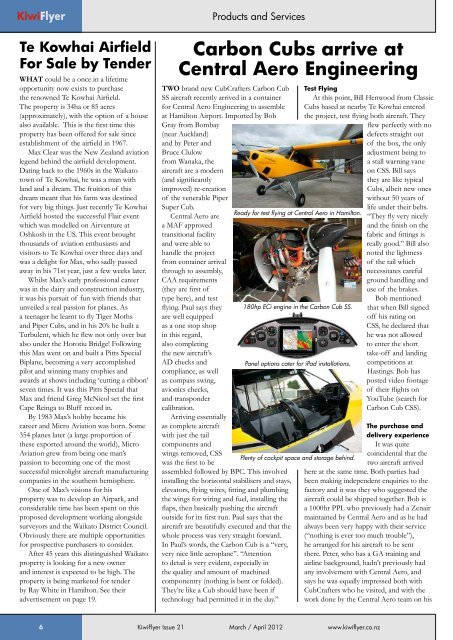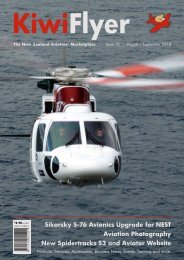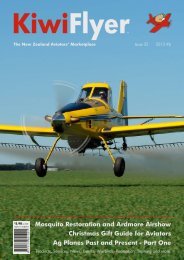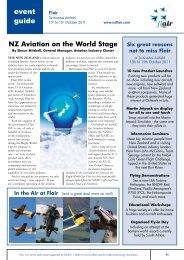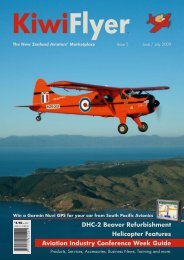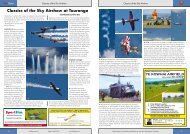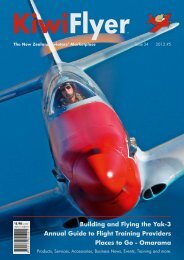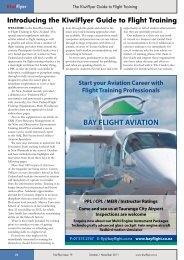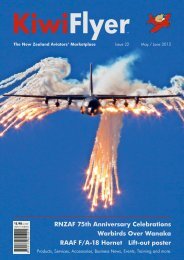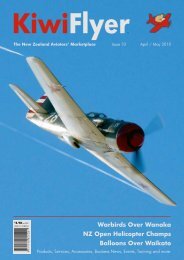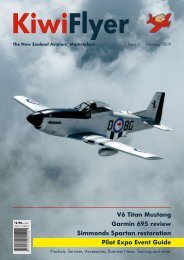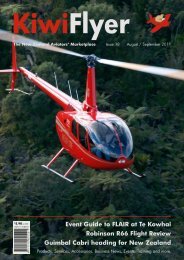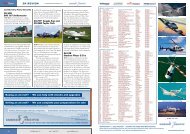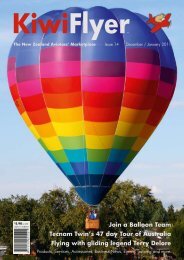Download Issue 21 complete - KiwiFlyer
Download Issue 21 complete - KiwiFlyer
Download Issue 21 complete - KiwiFlyer
You also want an ePaper? Increase the reach of your titles
YUMPU automatically turns print PDFs into web optimized ePapers that Google loves.
<strong>KiwiFlyer</strong><br />
Products and Services<br />
Products and Services<br />
Te Kowhai Airfield<br />
For Sale by Tender<br />
WHAT could be a once in a lifetime<br />
opportunity now exists to purchase<br />
the renowned Te Kowhai Airfield.<br />
The property is 34ha or 85 acres<br />
(approximately), with the option of a house<br />
also available. This is the first time this<br />
property has been offered for sale since<br />
establishment of the airfield in 1967.<br />
Max Clear was the New Zealand aviation<br />
legend behind the airfield development.<br />
Dating back to the 1960s in the Waikato<br />
town of Te Kowhai, he was a man with<br />
land and a dream. The fruition of this<br />
dream meant that his farm was destined<br />
for very big things. Just recently Te Kowhai<br />
Airfield hosted the successful Flair event<br />
which was modelled on Airventure at<br />
Oshkosh in the US. This event brought<br />
thousands of aviation enthusiasts and<br />
visitors to Te Kowhai over three days and<br />
was a delight for Max, who sadly passed<br />
away in his 71st year, just a few weeks later.<br />
Whilst Max’s early professional career<br />
was in the dairy and construction industry,<br />
it was his pursuit of fun with friends that<br />
unveiled a real passion for planes. As<br />
a teenager he learnt to fly Tiger Moths<br />
and Piper Cubs, and in his 20’s he built a<br />
Turbulent, which he flew not only over but<br />
also under the Horotiu Bridge! Following<br />
this Max went on and built a Pitts Special<br />
Biplane, becoming a very accomplished<br />
pilot and winning many trophies and<br />
awards at shows including ‘cutting a ribbon’<br />
seven times. It was this Pitts Special that<br />
Max and friend Greg McNicol set the first<br />
Cape Reinga to Bluff record in.<br />
By 1983 Max’s hobby became his<br />
career and Micro Aviation was born. Some<br />
354 planes later (a large proportion of<br />
these exported around the world), Micro<br />
Aviation grew from being one man’s<br />
passion to becoming one of the most<br />
successful microlight aircraft manufacturing<br />
companies in the southern hemisphere.<br />
One of Max’s visions for his<br />
property was to develop an Airpark, and<br />
considerable time has been spent on this<br />
proposed development working alongside<br />
surveyors and the Waikato District Council.<br />
Obviously there are multiple opportunities<br />
for prospective purchasers to consider.<br />
After 45 years this distinguished Waikato<br />
property is looking for a new owner<br />
and interest is expected to be high. The<br />
property is being marketed for tender<br />
by Ray White in Hamilton. See their<br />
advertisement on page 19.<br />
Carbon Cubs arrive at<br />
Central Aero Engineering<br />
TWO brand new CubCrafters Carbon Cub<br />
SS aircraft recently arrived in a container<br />
for Central Aero Engineering to assemble<br />
at Hamilton Airport. Imported by Bob<br />
Gray from Bombay<br />
(near Auckland)<br />
and by Peter and<br />
Bruce Clulow<br />
from Wanaka, the<br />
aircraft are a modern<br />
(and significantly<br />
improved) re-creation<br />
of the venerable Piper<br />
Super Cub.<br />
Central Aero are<br />
a MAF approved<br />
transitional facility<br />
and were able to<br />
handle the project<br />
from container arrival<br />
through to assembly,<br />
CAA requirements<br />
(they are first of<br />
type here), and test<br />
flying. Paul says they<br />
are well equipped<br />
as a one stop shop<br />
in this regard,<br />
also completing<br />
the new aircraft’s<br />
AD checks and<br />
compliance, as well<br />
as compass swing,<br />
avionics checks,<br />
and transponder<br />
calibration.<br />
Arriving essentially<br />
as <strong>complete</strong> aircraft<br />
with just the tail<br />
components and<br />
wings removed, CSS<br />
was the first to be<br />
assembled followed by BPC. This involved<br />
installing the horizontal stabilisers and stays,<br />
elevators, flying wires, fitting and plumbing<br />
the wings for wiring and fuel, installing the<br />
flaps, then basically pushing the aircraft<br />
outside for its first run. Paul says that the<br />
aircraft are beautifully executed and that the<br />
whole process was very straight forward.<br />
In Paul’s words, the Carbon Cub is a “very,<br />
very nice little aeroplane”. “Attention<br />
to detail is very evident, especially in<br />
the quality and amount of machined<br />
componentry (nothing is bent or folded).<br />
They’re like a Cub should have been if<br />
technology had permitted it in the day.”<br />
Ready for test flying at Central Aero in Hamilton.<br />
180hp ECi engine in the Carbon Cub SS.<br />
Panel options cater for iPad installations.<br />
Test Flying<br />
At this point, Bill Henwood from Classic<br />
Cubs based at nearby Te Kowhai entered<br />
the project, test flying both aircraft. They<br />
flew perfectly with no<br />
defects straight out<br />
of the box, the only<br />
adjustment being to<br />
a stall warning vane<br />
on CSS. Bill says<br />
they are like typical<br />
Cubs, albeit new ones<br />
without 50 years of<br />
life under their belts.<br />
“They fly very nicely<br />
and the finish on the<br />
fabric and fittings is<br />
really good.” Bill also<br />
noted the lightness<br />
of the tail which<br />
necessitates careful<br />
ground handling and<br />
use of the brakes.<br />
Bob mentioned<br />
that when Bill signed<br />
off his rating on<br />
CSS, he declared that<br />
he was not allowed<br />
to enter the short<br />
take-off and landing<br />
competitions at<br />
Hastings. Bob has<br />
posted video footage<br />
of their flights on<br />
YouTube (search for<br />
Carbon Cub CSS).<br />
The purchase and<br />
delivery experience<br />
It was quite<br />
coincidental that the<br />
Plenty of cockpit space and storage behind.<br />
two aircraft arrived<br />
here at the same time. Both parties had<br />
been making independent enquiries to the<br />
factory and it was they who suggested the<br />
aircraft could be shipped together. Bob is<br />
a 1000hr PPL who previously had a Zenair<br />
maintained by Central Aero and as he had<br />
always been very happy with their service<br />
(“nothing is ever too much trouble”),<br />
he arranged for his aircraft to be sent<br />
there. Peter, who has a GA training and<br />
airline background, hadn’t previously had<br />
any involvement with Central Aero, and<br />
says he was equally impressed both with<br />
CubCrafters who he visited, and with the<br />
work done by the Central Aero team on his<br />
new aircraft. He already has 30 hours on<br />
BPC and says its performance is remarkable<br />
(“like a Cub on steroids”) offering huge<br />
safety margins for operating off short strips<br />
in mountains and valleys.<br />
New Central Aero capabilities<br />
and recent work<br />
Paul says that Central Aero are now set<br />
up for in-house biennial avionics checks<br />
and that they have also recently expanded<br />
their sheet metal work capability with a<br />
Magnabend folder and a genuine English<br />
Wheel for rolling compound curves.<br />
In recent months they have <strong>complete</strong>d<br />
substantial repairs to a damaged Cessna 172<br />
and a damaged SportCruiser, as well as the<br />
normal ongoing maintenance for a growing<br />
number of clients, including an increasing<br />
number of helicopter operators. They are<br />
also currently re-commissioning a Mini 500<br />
helicopter that has been in storage. In Paul’s<br />
words, “We don’t have a too-hard basket”.<br />
For more information<br />
To find out more about Central Aero<br />
Engineering’s capabilities or the Carbon<br />
Cub project, contact Paul Waterhouse on<br />
0<strong>21</strong> 743 033, email: paul@centralaero.co.nz<br />
or visit www.centralaero.co.nz<br />
CubCrafters and the Carbon Cub SS<br />
CubCrafters is based in the US and<br />
began operations in 1980 to provide<br />
rebuilding services for the very popular<br />
Piper Super Cub. A community of likeminded<br />
enthusiasts developed around the<br />
company who were developing numerous<br />
improvements to the original design<br />
as rebuilds took<br />
place. Eventually<br />
they were not so<br />
much undertaking<br />
rebuilds, as building<br />
new airplanes. In<br />
1997 they expanded<br />
their manufacturing<br />
facilities and<br />
introduced a<br />
proprietary design,<br />
the Top Cub. More recently, in response to<br />
the LSA market, CubCrafters developed a<br />
100hp Sport Cub and the 180hp Carbon<br />
Cub SS which claims the shortest takeoff,<br />
fastest climb rate and shortest landing of<br />
any aircraft in its class.<br />
The Carbon Cub SS is a modern, high<br />
performance airplane that has taken the<br />
basic design of the Piper Super Cub<br />
and reinvented it using materials such as<br />
carbon fibre. The result is an aircraft that<br />
The Carbon Cub SS fitted with tundra tyres.<br />
is 250lb lighter and that has 50 percent<br />
fewer parts than a similarly equipped Super<br />
Cub. Its excellent power to weight ratio<br />
provides for a sea level climb rate of <strong>21</strong>00<br />
fpm. Power is provided by an ECi CC340<br />
engine, a version of a venerable Lycoming<br />
design having dual electronic ignition and<br />
lightweight accessory<br />
components. The<br />
250lb engine is rated<br />
at 180hp for takeoff<br />
and climb, and 80hp<br />
for continuous power<br />
settings.<br />
It all adds up<br />
to outstanding<br />
performance and the<br />
aircraft will takeoff<br />
lightly loaded in just a few multiples of its<br />
own length. It’s comfortable too, offering<br />
4” more shoulder width and a panel that is<br />
4” further forward than an original Cub.<br />
And the price? Standard pricing for the<br />
Carbon Cub SS listed on the CubCrafters<br />
website is US$164,000. There’s bound to<br />
be plenty of interest in the two aircraft<br />
that have just arrived in NZ and perhaps it<br />
won’t be too long before another arrives to<br />
join them. www.cubcrafters.com<br />
6 <strong>KiwiFlyer</strong> <strong>Issue</strong> <strong>21</strong> March / April 2012 www.kiwiflyer.co.nz<br />
News Briefs are included free of charge. Send your requirements to editor@kiwiflyer.co.nz or phone us on 0800 KFLYER 7


